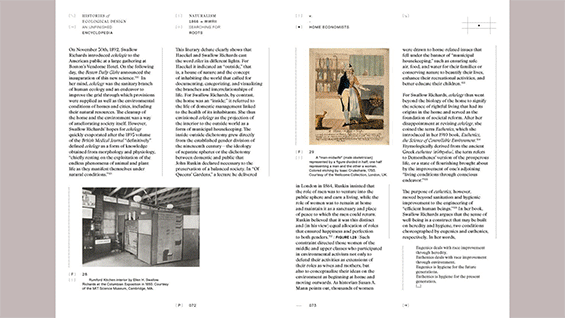Lydia Kallipoliti: Histories of Ecological Design—An Unfinished Cyclopedia
Thu, Apr 4, 5pm - Sun, Apr 28, 2024 5pm

This exhibition, held in the Third Floor Hallway Gallery, presents work from Associate Professor Lydia Kallipoliti’s new book, Histories of Ecological Design: An Unfinished Cyclopedia (Actar, 2024). In conjunction with the exhibition, Professor Kallipoliti will hold a book talk on April 18, followed by a reception.
The term ecological design was coined in a 1996 book by Sim van der Ryn and Stewart Cowan, in which the authors argued for a seamless integration of human activities with natural processes to minimize destructive environmental impact. However, ecological design harks as far back as Ernst Haeckel’s definition of the field of ecology and Henry David Thoreau’s manual for self-reliance.
Since World War II, contrary to the position of ecological design as a call to fit harmoniously within the natural world, there has been a growing interest in a form of a synthetic naturalism, where the laws of nature and metabolism are displaced from the domain of wilderness to the domain of cities, buildings, and objects. With the rising awareness of disturbances in the planetary reservoir, the field of ecological design has signified not only the integration of the designed object or space in the natural world, but also the reproduction of the natural world in design principles and tools through technological mediation. Rather than a deep appreciation for nature’s equilibrium, ecological design might commence with the synthetic replication of natural systems.
Histories of Ecological Design presents conflicting definitions and concepts of architects and designers and the parallel histories of their intellectual positions toward environmental thought from the 19th century to today. To survey the formation of this field, the context is not exclusively examined chronologically, but also in connected worldviews, each rendering evolving perceptions of nature, its relation to culture, and the occupation of the planet by human and non-human subjects. The book showcases that ecological design starts with the reconceptualization of the world as a complex system of flows rather than a discrete compilation of objects, which visual artist and theorist György Kepes has described as one of the fundamental reorientations of the 20th century.
In conjunction with the exhibition, Professor Kallipoliti will hold a book talk on April 18. The exhibition is open to current Cooper Union students, faculty, and staff. The book talk will be open to the public.
Located at 7 East 7th Street, between Third and Fourth Avenues




